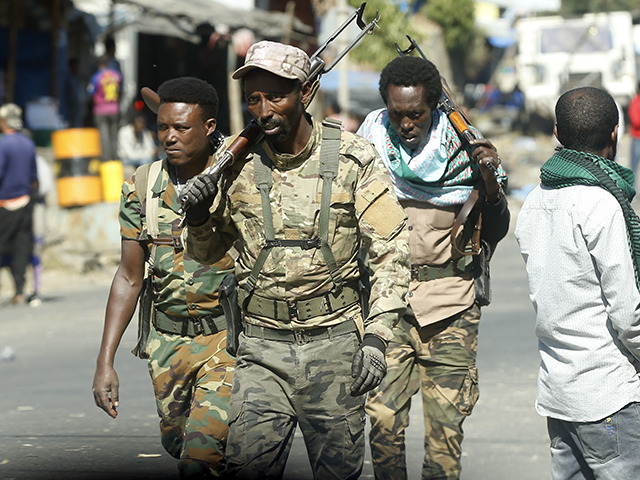Ethiopia’s civil war between the federal government and the Tigrayan People’s Liberation Front (TPLF) is not the only deadly ethnic conflict raging in that turbulent country. On Friday, residents of the Oromiya region reported digging mass graves for at least 42 villagers slaughtered by a rival tribal militia.
The killings occurred in the Amuru district of Oromiya, located about 230 miles west of the national capital, Addis Ababa. The area is largely inhabited by a people called the Oromo, who represent about a third of the Ethiopian population, making them the largest of Ethiopia’s dozens of ethnicities.
According to eyewitnesses, the killers belonged to a militia called Fano, which draws most of its manpower from a rival ethnic group called the Amhara. Witnesses said the attackers, who numbered between 150 and 200, were armed with rifles and spoke the distinctive Amharic language. Fano members tend to be young, often teenagers.
While the Oromo are numerous, they have little political power, even though current Prime Minister Abiy Ahmed hails from the Oromo region. Abiy ran as a member of an Oromo party, on a platform of addressing injustices against his people, but once in office he became much more concerned with centralizing power.
Some Oromo regard themselves as a captive nation, conquered centuries ago by invading tribes who became the modern Amhara and Tigrayans. Like many of Ethiopia’s feuding ethnic groups, the Oromo have their own militant movement, the Oromo Liberation Front.
Until Abiy became prime minister in 2018, the relatively small but influential Tigrayan minority held a great deal of power in the central government. Abiy’s efforts to reduce Tigrayan influence angered the TPLF, which eventually made an aggressive challenge to Abiy’s legitimacy, launching an insurrection in November 2020 that continues to this day.
The TPLF seized the initiative in the civil war and made a credible push to attack Addis Ababa, which prompted a defiant Abiy to take to the battlefield in person, calling upon his allies to “meet me at the front” and fight a “battle for Ethiopia’s existence.”
These developments were somewhat awkward for the international community, as Abiy was the recipient of a Nobel Peace Prize in 2019 for his contributions to making peace with Ethiopia’s neighbor Eritrea. The Nobel Committee issued an extremely rare statement of disapproval for Abiy in January 2022 over his brutal war against the TPLF.
Ethiopian conflicts tend to draw numerous tribes and factions into conflict, and all of them usually end up accused of crimes against humanity. The Tigrayan civil war was no exception, as every party involved on all sides was accused of civilian massacres.
One of the allies that rallied to Abiy’s banner was the Eritreans, whose troops entered Ethiopia to fight the TPLF. The Tigrayans have long memories of Eritrean brutality during the long border conflict Abiy was awarded the Nobel Prize for ending. Both Eritrean troops and the TPLF have been accused of raping and killing Eritrean refugees living in northern Ethiopia who were caught in the crossfire.
Another group that rallied to Abiy’s banner was the Ahmara, whose Fano militia proved crucial to blunting the TPLF offensive. The Fanos were as brutal as any other participant in the Ethiopian melee. In March, they were condemned for executing Tigrayan prisoners – in at least one documented case by burning them alive.
Abiy’s government turned against the Fano after the TPLF was pushed back into the Tigray region, deeming their aggressive nationalism a threat to the stability of his government. A crackdown on the Amhara in May resulted in thousands of arrests and gun confiscations, along with numerous casualties.
The Oromo and Amhara have clashed with increasing frequency over the past few months, a battle some weary observers describe as Ethiopia’s other civil war.
Oromo militias have also been accused of atrocities, including a gun rampage in June that killed hundreds of people, many of them ethnic Oromos. Oromiya has numerous ethnic sub-groups among its large population, and some of them have violent grudges against each other.
Oromo militants are likewise divided into feuding splinter groups that often blame each other for the worst violence, or accuse the Amhara of staging alleged Oromo attacks to justify an ethnic cleansing campaign.
In late 2021, the Oromo Liberation Army declared an alliance with the TPLF against the government. Abiy’s government, in turn, is formally joined with the Amhara in a three-way alliance with Eritrea against the TPLF.
A months-long cease-fire between the Ethiopian government and the TPLF collapsed at the end of August, threatening to make an already dire humanitarian situation even worse. On Sunday, Sudanese officials urged humanitarian agencies to evacuate refugee centers near the border as fighting in Ethiopia intensified.
Abiy’s government has also resumed its criticism of the most internationally famous ethnic Tigrayan, World Health Organization (W.H.O.) director Tedros Adhanom Ghebreyesus. Ethiopia’s ambassador to the European Union, Hirut Zemene, last week accused Tedros of “degrading” and “abusing” his office in a “completely unprofessional” manner by criticizing the Ethiopian government’s efforts to end the TPLF insurgency.
A spokesperson for W.H.O. shot back that Abiy’s campaign against the TPLF has inflicted severe shortages of food, health care, communications, and other hardships upon six million people over the past two years by keeping Tigray under siege.
“If people in Tigray had access to their finances, they would be able to buy medicines and any food that is available. But instead, malnutrition, preventable diseases, and outbreaks have increased, while access to health services has decreased just when they are needed the most,” the W.H.O. representative said.

COMMENTS
Please let us know if you're having issues with commenting.